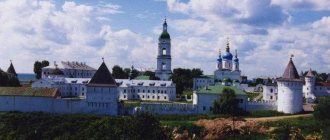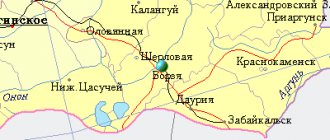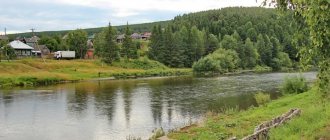Modern Tyumen is called the “oil and gas capital of Russia” because large production facilities for the extraction and processing of petroleum products are concentrated in the Tyumen region. The city is home to the Tyumen State Oil and Gas University (TyumenSU), which trains specialists for the Russian fuel and energy complex. According to labor market specialists, every second employee in the country’s oil and gas industry has a diploma from Tyumen State University.
Thanks to this prestigious educational institution, good jobs and developed infrastructure, the city is actively developing, and its population is constantly growing, mainly due to visitors. This is a thriving city with many young people, which means there is a great need for housing construction.
Siberian checkpoint of Russia
Tyumen is located in Western Siberia. Administratively, it belongs to the Ural Federal District. Historically, this is the first city of the Russian Empire that appeared in the Siberian lands.
The city owes its appearance to the conqueror of Siberia Ermak, who liberated these places from the proteges of the Horde four hundred years ago. Before that, for three centuries the capital of the Tyumen Khanate, Chingi-Tura, was located here. Chroniclers tell about the founding of the city: “In the summer of 7093 (according to the new chronology - 1586), the governors from Moscow Vasily Borisov Sukin, Ivan Myasnoy, and the written head Danilo Chulkov with three hundred people were sent, setting up the city of Tyumen on the 29th day of July.” The city was founded in a well-fortified place, on a cape, protected by ravines and two rivers with steep banks, and not in vain: at the beginning of its history, Tyumen was attacked several times by armies of nomads.
The heyday of Tyumen begins in the 19th century, which was especially facilitated by the construction of the Trans-Siberian Railway.
The second important stage of development begins in the 20th century, during the era of the development of oil deposits and the construction of industrial complexes.
The site where the city was founded was strategically important because the caravan road from Central Asia to the Volga region passed here. In later times, the city was a significant point of transit trade between China and Siberia. Now Tyumen has not lost its transport significance, being an important junction of the Sverdlovsk railway (Trans-Siberian highway).
The Roshchino airport of international importance is also located here. The waterways passing through the city are also heavily used.
Officially, the city of Tyumen is also the regional center of two autonomous okrugs, Khanty-Mansiysk and Yamalo-Nenets, and together with them constitutes the largest region of the Russian Federation.
Migration
At the end of 2022, the migration of the Tyumen region and the city itself was as follows: A total of 65.4 thousand people arrived in the region, including:
- Within the Russian Federation – 56.7;
- From other countries - 8.8 thousand people, including: from the CIS countries - 8.2; from non-CIS countries - 0.5.
A total of 49.7 thousand people left the region, including:
- Within the Russian Federation - 45.8;
- From other countries - 3.95 thousand people, including: from the CIS countries - 3.4; from non-CIS countries - 0.5.
Climate and its vagaries in Tyumen
The climate in Tyumen is very unpredictable and noticeably different from the usual weather in central Russia. In addition, it has changed noticeably over the past few years.
The weather in the region is influenced by both cold atmospheric fronts coming from Siberia and the dry winds of the Kazakh steppes.
Several decades ago, the region was famous for its frosty winters. The absolute minimum temperature in the entire history of observation was also noted in the last century, in 1958. Now temperatures of -30°C in January and February are the exception rather than the rule. On average, it is -15°C outside the window in January. Winters have become not only warmer, but also less snowy.
Winter in Tyumen lasts three to four months. Summer is also short, about three months, but quite warm (in July the temperature reaches 37°C, and on average stays at 18-19°C). Spring and autumn are long, with sudden changes in temperature even during the day. City dwellers are already accustomed to weather surprises, when in April in the afternoon you can walk to the park in just a T-shirt, and in the evening of the same day find yourself in a snowfall. The winds in the region are also capricious.
In general, the climate of Tyumen is classified as sharply continental. Despite frequent temperature changes, disasters or emergency situations rarely occur here due to weather conditions. Usually these are hurricane winds (in spring) and flooding of city streets due to rainfall (in summer). In terms of climate, the city is comfortable for living for all residents of the central part of Russia. Don't be afraid of “Siberian frosts”: they are rare here. But you will have to get into the habit of always preparing for the vagaries of the weather and, even on the clearest spring morning, taking a sweater or jacket with you.
List of films, songs, books dedicated to Tyumen
The Tyumen region is a harsh region. But even many literary and musical works are dedicated to him. The city has become an excellent backdrop for filming feature films. Here is just a small list of creative heritage:
- songs: “Tyumen Region Today” (N. Samusevich, S. Markovskaya), “Native Land” (N. Samusevich, N. Shamsutdinov), “Tyumen Waltz” (V. Selishchev);
- books: “In remote places: essays from life in Siberia” (N. Lukhmanova), “My memories” (N. Chukmaldin), “Life on the Big River: notes of a Siberian clerk” (P. Kochnev), “Dovecote on the Yellow Glade "(V. Krapivin);
- films: “Russian Children” (1998), “Lieutenant” (2015), “Response” (2016).
At the moment, Tyumen is experiencing a real “film boom”. Directors of various levels come here to make feature films and documentaries. Casting calls for roles are often announced on social media.
Despite high salaries in the region, the cost of a hotel room remains reasonable. If you want to come to a city celebration, you should book a room in advance, since most hotels are filled to capacity on holidays.
Video 3. Celebration in 2018
Alexander, June 7, 2022.
Ecology of the city of Tyumen
The state of air, water and green spaces in Tyumen in recent years has not pleased local residents. Oil and gas production is not environmentally friendly, therefore, with the beginning of the era of active production and processing of petroleum products, the concentration of harmful substances in the air has increased.
Also, a metallurgical plant was built a few years ago (despite public protests), and this also contributed to environmental pollution.
A peculiarity of the city is that some enterprises (machine tool plant, metallurgical plant, reinforced concrete products plant) do not have sanitary zones and are located within the city, near residential buildings). But cars remain the main air pollutant.
Tyumen ecologists count 848 enterprises in the city that have a harmful impact on the environment, and observe an increase in the concentration in the air of such harmful substances as formaldehyde (by 22%), nitrogen dioxide (by 16.1%), lead (7.7%) , carbon monoxide (3.6%). However, in the general environmental rating of Russian cities, Tyumen has not yet entered the top ten “dirtiest”. Although it did not become a leader in cleanliness.
Many residents are concerned about the decrease in the number of green spaces in the city (roads are being expanded to include lawns and tree plantings) and the expansion of the city boundaries, which pushes aside the surrounding forests. But at the same time, Tyumen still remains an attractive place to live, and its environmental disadvantages are compensated by economic advantages.
Number and density of population
The population of Tyumen in 2022 was 745 thousand people. This is the eighteenth indicator among all settlements of the Russian Federation.
Now let's calculate the population density of Tyumen. This indicator is the result of dividing the total number of inhabitants by the size of the territory. The area of Tyumen, as we found out above, is 698.5 square meters. km. Thus, having carried out the division procedure, it is not difficult to calculate that the density will be equal to 1067 people per 1 sq. km.
Population of Tyumen
Tyumen is one of the few cities in Russia whose population has been growing steadily over the past few years. Since 2005, the number of Tyumen residents has increased from 538 to 680 thousand people and is steadily approaching the 700 thousand mark. Moreover, the increase is partly due to natural reasons, and partly due to migration. Thus, in 2013, the birth rate was about 11 thousand people, the death rate was about 6 thousand people, and the migration increase was about 18 thousand people. Tyumen attracts residents of the region and other regions. Many young people come here hoping to find jobs; young people enter local universities and often remain to live and work in the city.
The population of Tyumen is quite diverse in terms of ethnic composition. About 80% of the population are Russians; a significant proportion are Tatars (approx. 6%), as well as Azerbaijanis and Armenians (in total - about 2%).
The regional Department of Labor helps compatriots living abroad with relocation and employment.
Ethnic composition
According to the 2010 census, the ethnic composition of the city and the entire region includes more than ten different nationalities. According to statistics, it can be noted that a larger number are occupied by nationality (thousands of people):
- Russians - 468.2, that is, 84.4% of the total population.
- Tatars - 33.98, that is, 6.1%.
- Ukrainians - 9.3, that is, 1.7% of the total.
- Azerbaijanis - 6.2, that is, 1.1%.
- Armenians - 5.2, that is, 0.9% of the total population.
- Germans - 3.5, that is, 0.6%.
- Kazakhs - 2.97, that is, 0.5% of the total.
- Chuvash - 2.8, that is, 0.5%.
- Belarusians - 2.2, that is, 0.4%.
- Tajiks - 2.0, that is, 0.4%.
- Others - 45.6, that is, 3.4% of the total.
There are no statistics on ethnic composition for 2022 or 2022.
Celebrities of Tyumen
One of the most famous natives of Tyumen is children's writer Vladislav Krapivin. More than one generation of Russian children grew up on his books “The Boy with the Sword”, “The Three from Place Carronade”, “Islands and Captains”. Vladislav Petrovich repeatedly described his hometown in his novels, both autobiographical and fiction. Now the writer lives in Tyumen, a city to which he devoted many years of his life and in which he did a lot of work organizing children's clubs and sections.
The second significant name for Tyumen is a theater and film actress, singer. She starred in films from the series “Always Say Always”; in the films “Two Fates” and “One of Our Own.” Now lives and works in St. Petersburg.
Yuri Gulyaev (People's Artist of the USSR, famous pop and opera singer) was also born in Tyumen; Bulat Yantimirov (participant of the Great Patriotic War, hero of the Soviet Union); Evgeny Bushmanov (famous football player, Russian national team player).
The most in-demand professions and industries
The most popular industries in the city are transport and real estate.
Most Popular Industries
| Industry | Salary (thousand rubles per month) |
| Real estate | 60 |
| Transport | 55 |
| Production | 40 |
| Engineering | 40 |
| Agriculture | 40 |
| Top management | 40 |
| Construction | 37,5 |
| Art | 35 |
| Education | 34,5 |
| Medicine | 30,7 |
Companies providing the largest number of vacancies in Tyumen:
- Industrial Safety Group;
- Gorenje BT;
- Group of window companies;
- Bilinguals;
- Center;
- Driver Recruitment Center;
- Pyaterochka;
- Holding;
- Service +;
- Cities.
Among the most in-demand professions are drivers and process engineers. Welders and machinists earn the most on a rotational basis.
The most in-demand professions in 2022
In-demand professions in Tyumen
| Profession | Number of vacancies |
| Driver | 1000 |
| Process engineer | 1000 |
| Secretary in the office | 973 |
| Office Manager | 512 |
| HR specialist | 371 |
| Taxi driver | 320 |
| Salesman-cashier | 269 |
| Internet manager | 246 |
| Lead Engineer | 161 |
| Manager `s assistant | 151 |
The highest paying professions
| Profession | Average salary (thousand rubles per month) |
| Argon welder | 136 |
| Shift driver | 92,5 |
| Installation operator | 90 |
| Pipelayer operator | 90 |
| Welder NAKS | 90 |
| Drilling rig operator | 90 |
| Truck crane operator | 82,5 |
| Chief mechanical engineer | 80 |
| PPU operator | 80 |
| Head of Sales Department | 80 |
Average salary of doctors
The average salary of a Tyumen health worker is about 40 thousand rubles per month. Periodontists and pediatricians earn the most.
Average salary of a doctor
Doctor's salary in Tyumen
| Period | Average salary (thousand rubles per month) |
| June 2021 | 35 |
| July 2021 | 45 |
| August 2021 | 40 |
| September 2021 | 45 |
| October 2021 | 43,2 |
| November 2021 | 50 |
| December 2021 | 50 |
| January 2022 | 40 |
| February 2022 | 40 |
Average earnings of doctors of various specializations
| Specialization | Average salary (thousand rubles per month) |
| Periodontist | 80 |
| Pediatrician | 55 |
| MRI Doctor | 45 |
| Laboratory diagnostics doctor | 31,5 |
| Reanimatologist | 31,4 |
| Doctor at the clinic | 30 |
| Cytologist | 30 |
| Physiotherapy doctor | 16,7 |
How much do teachers get paid?
The average salary of a teacher is about 20 thousand rubles per month. Head teachers and foreign language teachers earn the most.
Average teacher salary
| Period | Average salary (thousand rubles per month) |
| June 2021 | 25 |
| July 2021 | 25 |
| August 2021 | 25 |
| September 2021 | 20,4 |
| October 2021 | 25 |
| November 2021 | 20 |
| December 2021 | 21,5 |
| January 2022 | 20 |
| February 2022 | 21,5 |
Average earnings of teachers of various specializations
| Specialization | Average salary (thousand rubles per month) |
| Professor | 70 |
| Assistant professor | 60 |
| Head teacher | 60 |
| Foreign language teacher | 33 |
| Primary school teacher | 20 |
| Teacher of Russian language | 20 |
| Literature teacher | 20 |
How much does a driver earn?
The average earnings of a driver who has at least three years of experience in category B is about 60 thousand rubles per month. Forklift drivers earn the most on a rotational basis.
Average driver earnings
| Period | Average salary (thousand rubles per month) |
| June 2021 | 40 |
| July 2021 | 35 |
| August 2021 | 40 |
| September 2021 | 50 |
| October 2021 | 66 |
| November 2021 | 80 |
| December 2021 | 80 |
| January 2022 | 65 |
| February 2022 | 55 |
Average earnings of drivers of various specializations
| Driver (specialization) | Average salary (thousand rubles per month) |
| Loader on rotation | 100 |
| Truck crane operator | 80 |
| By car company | 80 |
| Tanker | 80 |
| Dump truck | 70 |
| KamAZ | 70 |
| Manipulator | 70 |
How much does the seller get?
The average salary of a salesperson is 20 thousand rubles per month. Meat sellers and stylists earn the most.
Average salesperson salary
| Period | Average salary (thousand rubles per month) |
| June 2021 | 20 |
| July 2021 | 20 |
| August 2021 | 22 |
| September 2021 | 20 |
| October 2021 | 20 |
| November 2021 | 20 |
| December 2021 | 20 |
| January 2022 | 20 |
| February 2022 | 20 |
Average earnings of sellers of various specializations
| Seller (specialization) | Average salary (thousand rubles per month) |
| Meat | 35 |
| Stylist | 33 |
| Auto parts | 30 |
| Food products | 30 |
| Opticians | 26,5 |
| Jewelry | 25 |
| Pet store | 25 |
| Cosmetics | 25 |
| Fruits and vegetables | 23,5 |
Economy of the region and city
The largest contribution to the GDP of the Tyumen region is made by industry (47.5%) and construction (15.4%). Tyumen is home to many enterprises that in 2013 shipped goods of their own production and performed work and services worth 141 billion rubles.
Main industries:
- oil and gas production
- mechanical engineering and metalworking, oil equipment,
- oilfield,
- drilling,
- geological exploration equipment,
- woodworking machinery,
- metal cutting machines,
- wood processing industry (industrial timber, lumber, panel materials),
- plastics,
- pharmaceutical products.
Tyumen enterprises play a significant role in the Russian economy. Thus, oil and gas production in Tyumen accounts for 2/3 of Russian oil and gas production; Tyumen also produces about 1/3 of all lead-acid batteries and accumulators produced in our country.
The largest enterprises in the region are, of course, oil and gas companies:
- JSC "Surgutneftegas"
- "Nizhnevartovskneftegaz"
- "Noyabrskneftegaz"
- "Yuganskneftegaz" (Nefteyugansk),
- Urengoygazprom (Novy Urengoy),
- "Yamburggazdobycha"
Next in the ranking are machine-building companies: Motor-Building PO, Automotive Equipment Plant JSC.
Surgut State District Power Plant-1 and State District Power Plant-2, Nizhnevartovskaya State District Power Plant, energy companies are also among the large enterprises of the region.
Agriculture in the region is poorly developed (accounting for less than 1% of the total gross regional product) and is represented mainly by meat and dairy farming. A large share of Tyumen's budget is spent on the social sector. Second place is occupied by investments in industrial enterprises. In 2014, city governors focused on the housing and communal services sector and invested about 10% of all budget money in it. As for specific figures, in 2014 the expenditure side of the Tyumen budget amounted to 16,582 and for the first time in several years exceeded the revenue side.
Gender and age
The age group is divided into: younger than the working population (from 0 to 15 years), able-bodied (from 16 to 59 years for men, from 16 to 54 years for women) and older than the working population (from 60 and older for men, from 55 and older for women) ).
It is worth considering in detail the gender and age group of the Tyumen region at the beginning of 2022 (thousands of people):
- Population distribution by gender: men - 722.0; women - 796.7.
- Distribution by working ability: younger than able-bodied - 329.9; working population - 851.5; older than able-bodied – 337.4.
Investments
The rapid pace of development of the city, good standard of living, high pace of construction and a large number of enterprises make it extremely attractive to investors. Despite the fact that Tyumen is located far from the center of Russia, it is advantageously located in terms of transport routes. Therefore, in the last few years, large investors, as well as well-known retail chains, have been coming here; A lot of commercial real estate and housing are being built.
For example, in the first half of 2013, the volume of investments in fixed capital in the Tyumen region (including districts) amounted to 631,854.794 million rubles, and in 2014 it increased to 683,995.8 million rubles.
The regional government is actively attracting investors, citing tax breaks, federal incentives and support for organizing and developing businesses as the region's advantages.
Marriages and divorces
Statistics on divorce proceedings in the Tyumen region read as follows: “Residents of Tyumen and the Tyumen region are more likely to get divorced than to get married.” It is necessary to consider the statistics of 2022 in more detail to find out whether it is true or false.
According to statistical data for May last year, 567 Tyumen couples managed to register a divorce, 448 couples registered their relationship in the registry office. This ratio of divorces accounts for half of the Tyumen region. In May, not a single marriage was registered in the Yurginsky district of the Tyumen region. But for the whole of May, according to the regional center, 308 married couples managed to get divorced, and 288 couples registered their relationship.
The same statistics were recorded for the following districts: Sorokinsky, Berdyuzhsky, Aromashevsky, Armizonsky. The number of marriages was 54 couples, and the number of registered divorces was 42 couples. According to official data, at the end of 2022 the statistics were as follows:
- Marriages - 9,730 couples registered their relationships.
- Divorces - 6,854 couples registered divorce.
Where to go to work?
Most city residents are employed in the oil and gas industry, because it is a city-forming industry. Such enterprises are considered the most profitable and promising in terms of employment. The “leading four” are Lukoil, TNK, Gazprom and Schlumberger. Their subsidiaries are also located here:
• OJSC Zapsibgazprom: concern for the production of equipment. operating on gas (a subsidiary of OJSC Gazprom); • OJSC Tyumenneftegaz is a hydrocarbon production company (part of the TNK-BP group of companies);
A well-known and promising company from the point of view of employment is a company engaged in transporting oil through main oil pipelines.
Mechanical engineering is the second major industry in the region. There are dozens of enterprises producing various equipment and components here: Battery, TyumenMedico (production of medical equipment), shipbuilding and ship repair enterprises. This leaves ample employment opportunities for a person with a technical background.
There are many construction companies operating in the city as construction progresses at a high pace. Therefore, professions related to construction are also in demand.
In Tyumen there are several dozen light and food industry enterprises (production of clothing, footwear, furniture; flour mills; bread, dairy, meat industries, etc.).
Capital of the oil and gas industry
As mentioned above, Tyumen is the capital of the Russian oil and gas industry. It's time to talk about this in more detail.
Oil began to be produced on an industrial scale in the region only in the 60s of the 20th century. But the launch of production played a decisive role in all further economic and social development of the city and region. This factor also had an impact on demographics, because many families from other regions of the USSR began to move to the developing region. In particular, this led to the fact that over several decades, as we saw above, the population of Tyumen increased significantly.
Although the majority of oil and gas fields are not located near Tyumen, but much further to the north (in particular, in the Khanty-Mansiysk (oil) and Yamalo-Nenets Autonomous Okrug (gas)), nevertheless, it is in the regional center that there is a significant number of management companies. In addition, a large number of people directly employed in this industry live in the city. That is why Tyumen has the status of the oil and gas capital of Siberia and Russia as a whole.
The activities of such large companies involved in the production and processing of oil and gas are associated with this region: Gazprom, Rosneft, Tyumen Oil Company (TNK) and many others.
Tyumen Industrial University, which until 2016 was called Tyumen State Oil and Gas University, prepares specialized personnel for the industry.
Construction in Tyumen. Housing prices in new buildings
According to analysts, the pace of construction in Tyumen has been slowing down in recent years. This is due to the fact that the market is quite saturated, and buyers are more focused on secondary housing. But at the same time, the city continues to occupy first place in the Urals in terms of the number of housing under construction in terms of the number of residents.
The leaders in the number of square meters delivered in 2014 were the MZhK and Moskovsky Trakt districts (in each of them, developers offered about 1,000 apartments for sale).
Other areas with active development are Tarmany, Tyumen microdistrict, Center, Cape, Vostochny-2.
Outsiders - areas with low construction rates - in 2014 remained Zarechny microdistrict, 2nd Zarechny microdistrict, 3rd Zarechny microdistrict, First microdistrict, Vostochny-3 and Neftyanikov.
The unit price per square meter, according to a large Tyumen realtor, was 56,245 rubles/sq.m.
The unit price of new buildings in Tyumen has not changed for several years and remains consistently high. In Tyumen, mainly budget housing is being built, but in some areas elite houses are also being put into operation (for example, in the KPD area).
Average price on the primary housing market in different areas of the city (data for 2014):
| Center | 83308 RUR/m2 |
| European microdistrict | 73029 RUR/m2 |
| Vostochny-3 | 63503 RUR/m2 |
| area of the Chervishevsky tract | 63204 RUR/m2 |
| Neftyanikov village | 40771 RUR/m2 |
Thanks to the developed timber industry, many private cottage-type houses are being built in Tyumen and the region.
The city authorities are also actively developing infrastructure, in particular, they are building kindergartens at a rapid pace. Now it has been possible to fill the need for such institutions for children from three to seven years old, but the authorities aim to continue the program until all Tyumen children from one and a half years old are provided with preschool institutions.
There is a very high demand for secondary housing in Tyumen. Apartments in old houses are also bought by migrants from the Far North (residents of the autonomous okrugs: Khanty-Mansiysk and Yamalo-Nenets), who receive certificates for housing under the federal program and prefer to use them to purchase “resales”. New apartments are also quickly moving into the “secondary” category, because many residents of Tyumen have income that allows them to carry out real estate transactions: buy apartments under construction for the purpose of resale.
Dynamics of population
But the population of Tyumen, of course, is not a constant value. This is a dynamic indicator that is constantly changing. Let's trace how many people lived in Tyumen during different periods of the city's existence and determine the main trends.
The first information about the number of residents living in Tyumen dates back to 1624. Then in the prison, which was the modern city at that time, there were only 479 people. By 1741, the number had already increased to 1,741 people. In 1868 the number of inhabitants reached 14,408 people. After this, there was a slight decline in numbers, but nevertheless, by the end of the century, the number of residents doubled compared to the previous figure and amounted to 29,500 people. Even the revolution and the Civil War did not lead to a decrease in population. She was just growing. In 1913 and 1923 it was 39.2 and 42.4 thousand inhabitants, respectively. By the beginning of World War II, 79.2 thousand people already lived in the city.
In the post-war years, the upward trend in numbers continued. In 1956, the city was already inhabited by 125.0 thousand people. The beginning of the development of oil fields in the 60s led to the fact that the population of the city increased by more than 2.5 times in less than 20 years. So in 1975 it was 330 thousand people.
The growth continued until 1992, when the number of residents amounted to 496 thousand people. But then a period of decline began, associated with the general demographic situation in the country after the collapse of the USSR and the state of the economy. In 1993 and 1994, the number of inhabitants was 493 and 491 thousand people. respectively. But after this, growth recovered, and by 1999 the number of residents amounted to 503.8 thousand people. The next period was characterized by fluctuations: years of population growth were followed by times of decline, and vice versa. But in general, by 2005 the number of residents amounted to 538.3 thousand people. and since then it has been growing steadily. The only exception is 2011, when there was a decline.
The number of residents of Tyumen has been increasing especially rapidly in recent years. Thus, from 2012 (609.7 thousand people) to 2022 (745.0 thousand people) it increased by more than 136 thousand people. The basis for this increase is largely not natural growth, but migration. In addition, at the end of 2013, 19 settlements that were previously part of the city district were included in the city. Due to this alone, the population increased by 22.3 thousand people.
City districts
Tyumen is divided into four administrative districts: Central, Leninsky, Kalininsky and Eastern. Each of them is divided into microdistricts, which also have their own names.
Central Administrative District
Tyumen is interesting because its business and historical center does not form a separate district. The central district of Tyumen is the business part of the city, the residential areas of Zarechye, and even a number of villages that found themselves within the city limits after the expansion of the city. In the Central region there are institutes and universities, offices of large companies, administrative buildings, and city courts. The central region is divided in half by the river. Tura, which is crossed by two automobile and one pedestrian bridge. This creates inconvenience for city residents, because bridges are always a “bottleneck” in the transport system.
Leninsky administrative district
Industrial sector of the city: most industrial enterprises are located here.
Eastern administrative district
Separated from Leninsky in 2008. The most developing area of the city. New houses are being built here at a rapid pace; Large shopping malls, Lenta, and Auchan, which is under construction, are located here. Tyumen CHPP-2 is also located here.
Kalininsky administrative district
Like Central, it partially includes the historical part of the city: the former Settlement and Yamskaya Sloboda. Key transport facilities are located here: airport, railway station. Cultural and recreational facilities are concentrated here: Zatyumensky Park and many landscaped public gardens.
In addition to the official division into four districts, the entire city is divided into villages and microdistricts, which have their own numbers or names (often slang, used only among residents).
Around the city there are a large number of holiday and cottage settlements, as well as villages.
Transport connection
Due to the fact that Tyumen is an important industrial and business center of Russia, transport links with the city are very well established. In fact, it is a hub settlement. The city has two airports: Roshchino and Plekhanovo. The first of them has international status.
Four federal highways pass through Tyumen, connecting the city with Yekaterinburg, Omsk, Khanty-Mansiysk and Roshchino airport. The city also has a railway junction station, which is part of the Trans-Siberian Railway.
But with public transport in Tyumen, things are not so good. The city has a developed bus fleet, but the trolleybus service was closed in 2009. Since then, Tyumen has become the largest city in the Russian Federation without electric transport.
Interesting buildings and attractions of Tyumen
Tyumen is a beautiful city, combining a bright modern appearance and carefully preserved historical monuments. Here are some of the most famous attractions loved by citizens and visitors to the city.
Historic and unusual buildings:
- Znamensky Cathedral. An amazingly elegant building in the Baroque style, with characteristic tiers and ornaments. Built in 1786
- Holy Trinity Monastery. The oldest building in the city; built at the beginning of the 17th century. The monastery complex consists of a cathedral and a church. The monastery is made in a single architectural style, atypical for Siberia - in the Ukrainian Baroque style.
- The building of the Agricultural Academy is another one of the oldest buildings in Tyumen. The author of the project is the famous St. Petersburg architect Vorotilov. In a beautiful two-story building located on the street. Respubliki, 7, formerly housed the Alexander School. Museum of Geology, Oil and Gas. The building in the Art Nouveau style is also located on the street. Republic. It contains unique exhibitions dedicated to geological exploration and oil production in the region.
Monuments:
One of the new and unusual attractions of the city is the Siberian Cat Square. The landscaped square is decorated with 12 cat figures. This is a monument to animals sent to Leningrad after the blockade was lifted to exterminate hordes of rats.
Monument to Yuri Hervieu. The famous discoverer of Tyumen oil largely determined the current status of Tyumen as an “oil capital”.
Cultural sites:
- Tyumen Regional Museum of Local Lore. One of the largest museums in Siberia, telling about the nature and history of the Tyumen region.
- Tyumen Regional Museum of Fine Arts. There is a wonderful collection of paintings by Russian artists - classics of the genre.
- .Tyumen Puppet Theater. A winner of international festivals, the theater delights audiences every year with new programs for children and adults.
As for the architectural symbols of the city, they are the Bridge of Lovers (one of the bridges over the Tura, an openwork structure with cables) and Tsvetnoy Boulevard - a pedestrian street, the “Tyumen Arbat”.
Tyumen is one of the most vibrant cities in Siberia. Despite the distance from the center, the city is actively developing industry and infrastructure, and therefore is attractive both for living and for investment. Tyumen is the oil and gas capital of Siberia, but, unlike many industrial cities, it is also a cultural and historical center attractive to tourists
Modern times
Now in Tyumen there are 14 research institutes and design organizations, a state university, a medical academy, institutes: industrial engineering and construction, agricultural, arts and culture, dozens of secondary special and general educational institutions.
There are 3 theatres, a philharmonic society, a circus, a local history museum (founded in 1879) with several branches in Tyumen and on Lake Andreevskoye, a museum of fine arts (1957) and others. Communities are registered: Orthodox, Muslim, Catholic, Jewish, Armenian Apostolic Church, Jehovah's Witnesses, Hare Krishnas and several Protestant organizations of various directions.
Engineer salary
The average salary of an engineer is 30 thousand rubles per month. Industrial safety engineers earn the most.
Average salary of an engineer
| Period | Average salary (thousand rubles per month) |
| June 2021 | 31 |
| July 2021 | 35 |
| August 2021 | 35 |
| September 2021 | 35 |
| October 2021 | 40 |
| November 2021 | 40 |
| December 2021 | 40 |
| January 2022 | 40 |
| February 2022 | 40 |
Average earnings of engineers of various specializations
| Specialization | Average salary (thousand rubles per month) |
| Industrial Safety Engineer | 70 |
| Chief Energy Engineer | 60 |
| Production and technical department engineer | 60 |
| Energy Engineer | 60 |
| Security Engineer | 50 |
| Chief Project Engineer | 50 |
| IT engineer | 46 |
| Leading process engineer | 45 |
| Leading Design Engineer | 45 |










